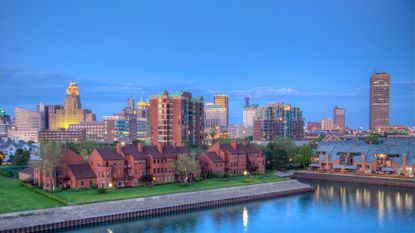Places that will become climate refuges
The Midwest may become the new hotspot to move


Climate change is making more places uninhabitable and causing dangerously high temperatures, extreme weather and rising sea levels. With these outcomes, more regions are becoming uninsurable and are prompting people to relocate to more stable locations. Certain U.S. cities are emerging as potential climate safe havens because they are experiencing the effects of climate change at a slower pace. However, no locale is fully exempt from the effects, and as the conditions worsen, even safe havens will become dangerous to inhabit. These four cities could see a large influx of people displaced by climate upheaval.
Buffalo, New York
Buffalo, located in the northern part of the state, has long been a contender for a climate refuge. The city has "climate-friendly geography" and its population has "shrunk by the hundreds of thousands since the 1950s," making the city eager to welcome new residents, The New York Times reported. Buffalo's proximity to the Great Lakes allows it to stay cooler than many other areas. The city rarely hits 100 degrees Fahrenheit, CNN reported.
Buffalo has been preparing to accept more climate refugees. The city "revised zoning codes in 2017 to encourage development in existing city corridors and began upgrading its dated sewage infrastructure," National Geographic reported. "Again, no one is immune, but I think when you look at some of the assets that we have in this region, it does give us the ingredients to, I think, chart a path in a climate-change world," Ryan McPherson, the University at Buffalo's chief sustainability officer, told Government Technology.
Subscribe to The Week
Escape your echo chamber. Get the facts behind the news, plus analysis from multiple perspectives.

Sign up for The Week's Free Newsletters
From our morning news briefing to a weekly Good News Newsletter, get the best of The Week delivered directly to your inbox.
From our morning news briefing to a weekly Good News Newsletter, get the best of The Week delivered directly to your inbox.
Ann Arbor, Michigan
Also located on the Great Lakes, Ann Arbor will likely see a steep growth in population in the coming decades. Researchers have identified Michigan in particular as a "destination for people seeking to escape the storm-ravaged Southeast or the parched Southwest," Grist reported. The state has also experienced population loss over time which may be remedied by people relocating, Bridge Michigan noted.
Ann Arbor also created a "comprehensive city effort to manage stormwater and stay ahead of flooding as the climate warms and rainfall increases," Planet Detroit reported. Jennifer Lawson, Ann Arbor's water resources manager, told the outlet, "How can the city bounce back from impacts from large rain events? If we have flooded streets, if we have flooded parks? What can we do to lessen the impact on the community as a whole?"
Duluth, Minnesota
Duluth was deemed "climate-proof Duluth" in 2019 by a Tulane University professor because of its "ample supply of freshwater," its location "buffered from sea-level rise in the Upper Midwest" and temperatures "which run mild in the summer and colder than cold in the winter," The New York Times reported. "Duluth is embracing the idea of itself as a climate safe haven," CNN reported.
"The idea that we are so ignoring the needs of our planet that people have to move is terrifying. It's dystopian," Duluth Mayor Emily Larson told the Times. She has worked to improve the city's carbon footprint as well as to build better housing for residents. "People need climate refuge, but there's the potential of a seismic conflict. So far, we're navigating it."
Columbus, Ohio
Architectural Digest named Columbus as the eighth most climate-resilient city in the country. "The city's climate is generally mild, with warm summers and cool winters, and its location inland makes it less prone to the devastating effects of hurricanes and other extreme weather events," a new report detailed.
The Midwest has a number of potential havens because it "holds special appeal with its abundant fresh water, cooler summers and comparatively little risk from hurricanes and wildfires," Grist reported. But, while these regions are safer for now, combating the climate crisis is still critical. "How we respond as a species, as a society, as individuals, I think will really determine what is a 'refuge' for us and what isn't," Vivek Shandas, professor at Portland State University, told the outlet.

Continue reading for free
We hope you're enjoying The Week's refreshingly open-minded journalism.
Subscribed to The Week? Register your account with the same email as your subscription.
Sign up to our 10 Things You Need to Know Today newsletter
A free daily digest of the biggest news stories of the day - and the best features from our website
Devika Rao has worked as a staff writer at The Week since 2022, covering science, the environment, climate and business. She previously worked as a policy associate for a nonprofit organization advocating for environmental action from a business perspective.
-
 5 hilarious cartoons about the George Santos expulsion vote
5 hilarious cartoons about the George Santos expulsion voteCartoons Artists take on Santa versus Santos, his X account, and more
By The Week US Published
-
 Places that are already seeing a boost in tourism due to climate change
Places that are already seeing a boost in tourism due to climate changeThe Explainer Warmer temperatures are moving travelers north
By Devika Rao, The Week US Published
-
 6 snow-or-sun hotels to visit this winter
6 snow-or-sun hotels to visit this winterThe Week Recommends Make your winter dreams a reality at these properties
By Catherine Garcia, The Week US Published
-
 A23a: why world's biggest iceberg is on the move
A23a: why world's biggest iceberg is on the moveThe Explainer The mass of ice is four times the size of New York and 'essentially' an island
By Chas Newkey-Burden, The Week UK Published
-
 Cop28: is UAE the right host for the climate summit?
Cop28: is UAE the right host for the climate summit?Today's Big Question Middle East nation is accused of 'pushing for a green world that can still have its oil'
By Chas Newkey-Burden, The Week UK Published
-
 Scientists have their eyes on 2 supervolcanoes
Scientists have their eyes on 2 supervolcanoesThe Explainer 'The probability of a catastrophic eruption is low but not nil'
By Devika Rao, The Week US Published
-
 Want to understand climate change? Look to the clouds.
Want to understand climate change? Look to the clouds.The Explainer Scientists are still uncovering the role clouds play in climate change
By Devika Rao, The Week US Published
-
 6 looming climate tipping points that imperil our planet
6 looming climate tipping points that imperil our planetThe Explainer A UN report details the thresholds we may be close to crossing
By Devika Rao, The Week US Published
-
 'Danger to life' warning as Storm Ciarán hits UK shores
'Danger to life' warning as Storm Ciarán hits UK shoresSpeed Read Schools closed and train, plane and car travel disrupted as Met Office issues weather warnings
By The Week UK Published
-
 The drying Amazon rainforest: a drought that affects the world
The drying Amazon rainforest: a drought that affects the worldUnder the radar The Amazon is suffering a drought of historic severity and it’s pushing its inhabitants to their limit
By The Week UK Published
-
 Under Antarctic ice lies a hidden landscape
Under Antarctic ice lies a hidden landscapeSpeed Read Climate change may reveal it over time
By Devika Rao, The Week US Published










